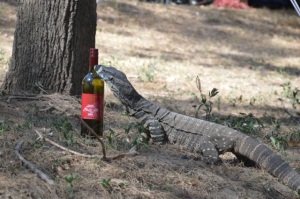Our little operation is very small in the world of wine, almost a minnow on the surface of an industry defined by status, fashion and ego. In many respects we really shouldn’t exist – we are such a small player in Australia’s newest and perhaps most challenging wine region. At times it can be hard, balancing the art of making elegant and fine wine with the necessary book keeping ledger in our MYOB computer package. Finances ebb and flow depending on the season, customers, expenses and family holidays.
When one is in a season of ebbing, we can start to make interesting and often comical business decisions in order to get things done. As you can imagine, I’ve developed a new appreciation for the farmers ability to improvise. And sometimes, the limits of natural common sense may be pushed in order to get things done. One of our machinery cornerstones is a 1971 International 454 tractor. It’s a great old girl that I inherited from my father-in-law – almost a family heirloom. Being 33 years old, many features have long stopped working – and that’s OK when talking about things like indicators and lights, but when it extends to brakes, clutch, accelerator and fuel delivery things become interesting.
We share-farm another vineyard at Black Mountain, located 57km from our winery. It is an isolated block, and last month a multitude of birds arrived due to the drought to attack the grapes. This one particular week we tried every which way to net the grapes. The new tractor at the Black Mountain block? Turned out it was too wide for the rows. Using a frame on a trailer ? Broke the hitch. Borrowed a tray back ute 4WD with another frame? The rolls were too big for the frame.
So I decided the only option was to take our old Inter tractor down to the vineyard. For such a short journey, I thought the ideal solution would be to drive the back roads between Glencoe and Black Mountain and use an old front end loader that we have to put on the nets.
I recall tasting a wine once from the Mornington Peninsula called “Ten Minutes By Tractor”. The grapes for the wine came from vineyards that were ten minutes apart by tractor. It turns out our vineyards are 190 minutes apart by tractor! I’d ridden the road before and driven it in the ute many times, but 3hrs and 10 minutes on a 1971 tractor with limited working features and an open cab can only be described as special.
It wasn’t long before I noticed I was being gained on by a brand new “New Holland” tractor…a council unit and very sleek. The driver must have been travelling at all of 40km/hr because he easily ate up the ground between himself and me. He quickly overtook me and looked a bit sheepish. Still, I gave him a big wave – I must have looked a sight with my white iPod earphones trailing out from my earmuffs going flat bicky at 20km/hr on my 1971 rocket!
As it turns out this guy was doing some slashing here and there, and I kept overtaking him and then he in turn would overtake me. Each time the poor guy obviously felt very awkward about the wave. Of course, not wanting to be seen as rude, I would give him a big friendly wave each time we passed.
About 5 or 6 km up the old Ben Lomond Road I come across him again, and behold this time I seemed to be gaining on him. What do you know…? He’s broken down, hood up with the twin radiators blocked with seed. Me stopping to help was always going to be awkward for the poor devil. Very politely he refused my help and I got on my way – he never caught up again.
It’s quite a climb to Ben Lomond village – we’re at 1150m above sea level and the village is at 1400m. We made it despite the clutch slipping, having to change down gears up the steep hill and the dangers of stalling.
Through the village I noticed a sign – 22km to Guyra. Now, in the regular world that might seem close, but on an old Inter that seemed like hours. The monotony was soon broken as I came across two mobs of cattle feeding on the road due to the drought. Hopefully, by now you’ll have gathered that I don’t take life too seriously, and I was quite interested to observe the two mobs.
The first was a large mob of black Angus cows and calves in the charge of a young jackaroo fully equipped with dogs and a new quad. Well….I swear these cows had never seen a tractor before, they ran every which way. Imagine 20 of them nearly over the fences, the young jackaroo roaring up and down the road, dogs yapping, all trying to keep them in. Frankly, I was relieved to get through them, and for all I know I may well have caused the next great stampede as they charged past me.
Not even 2km down the road, the next mob were different. Those old Hereford cows weren’t moving for me and my tractor, or the Prime Minister. I slowed down to a crawl and wove in and around every one of roughly 200 cows. And then I spied an old timer sitting on a quad in the shade of a tree with that all-knowing smile.
It was an interesting observation on how two seemingly similar situations can be very different.
The rest of the trip was rather uneventful except for going through Guyra. Julie kindly bought me a coke, so I pulled up on the descent into town. After two hours of slow going, I thought I’d turn off the tractor and enjoy the cool drink…. which was OK until I remembered that the alternator had quit 🙂


